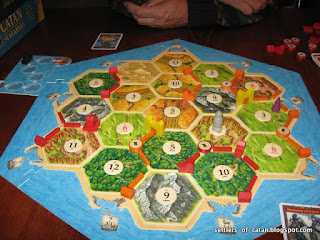But I knew from experience how important it is to have a supply of wheat in Cities and Knights. The best hex for wheat was the 5 at the top... but I wasn't so keen on the sheep-2 it was bordering. So my first choice was the intersection on two wheat (10 and 11) and an ore on 9. We seem to get a lot of 9s so I like to have at least one.
Richard then took the 4-8-10 (clay, sheep and wood) for his first settlement, and then the only remaining intersection where he could get both ore and wheat, giving him 3-4-8 (wheat, ore and wood). Then it was me to place my second settlement and a city, so I went for a 3-6-9 (sheep, clay, ore) and put my city on a 5-6-11 (wood, sheep, wheat). I had all the resources, but no 4 or - more worryingly - 8.
Richard placed his city on a 4-6-11 (ore, sheep, clay) meaning that he was lacking the numbers 5 and 9. If I were him, I'd have taken the 5-9-10 hex on two wood and an ore for my city. Perhaps I should have done myself; but from experience I prefer to get the commodities that go with sheep and wood rather than ore if possible. I'm not keen on the progress cards that come with the 'coins'.
I even remembered to take a photo of the initial setup:

At first, Richard did pretty well. 8s were rolled several times, giving him sheep and wood, while I had nothing. He had to trade lots of ore for clay in order to build, but did start expanding and quickly took that useful 5-9-10 hex, and upgraded it to a city as soon as he could in order to start his city improvements.
I collected cards more slowly, but did buy and then upgrade a knight; and since I was getting a trickle of wheat I was able to activate it before the first barbarian attack; since we each had one city at the time, we beat it and I was 'defender of Catan'.
We each then bought one more knight, and also built one more city each as the barbarians approached Catan for the second time. Richard activated his, and I'd activated my double-strength knight... but, alas, didn't have the wheat for my second knight. So when the barbarians attacked, we were defeated. Which meant that Richard, as the weaker knight-wise, had a city turned back into a settlement.
Except that he didn't have any settlements left. He'd built them all. The rules did not make mention of this possibility.
So we decided to turn one of his cities on its side, so that we knew it was now a settlement:

So, whereas he had been ahead by one point, we were now equal on nine points each. Eight points in buildings; I had a 'Defender of Catan' point and he, as often happens, had control of the merchant.
I doubt if anyone's actually following this in anywhere near as much detail as I'm typing... but just in case anyone spots that the numbers aren't quite the same, it's not a mistake. I had picked up the progress card that allowed me to exchange two numbers on the board, so long as they were not 2, 12, 6 or 8. I pondered for quite some time but eventually simply switched the 5 and 11 on wheat. Unfortunately when Richard took control of the robber he'd wanted wheat, so placed it on the 5.. which is why I couldn't activate my second knight prior to the second barbarian invasion.
The barbarians didn't arrive a third time. We rolled more than the usual number of green, blue or yellow with the event-die and started developing our cities further. With just six road pieces, I gained the longest street. Then suddenly I started collecting cards. Richard rolled a five; by then I had two cities on the wheat-5, so it gave me four wheat cards, plus a wood and a book commodity.
I had a huge handful of cards... if I'd rolled a 7, I would have lost a lot. But I rolled yet another 5. I had the wheat harbour. I also had the merchant card - unusually - and a lot of sheep. So I was able to do a lot of trading in my turn. I wasn't really thinking strategically at all; I simply wanted to reduce the number of cards in my hand. I had a couple of other useful progress cards (one gave me yet more wheat; one allowed me to build a city improvement for one commodity less than was required). I do like being able to play several development cards at a time.
So, going slowly, I built one metropolis. Then realised I could built the other, so thought I might as well do that too.
'Have you won?' asked Richard. I was a little surprised... I thought we were still some way off the end. I still had a city unbuilt, and only one 'Defender of Catan' card. But I counted up, and he was correct:

11 points in regular buildings, 4 extra for metropoloi, 2 for the street, 1 for the merchant, and one card. 19 in all, to Richard's 10.



No comments:
Post a Comment